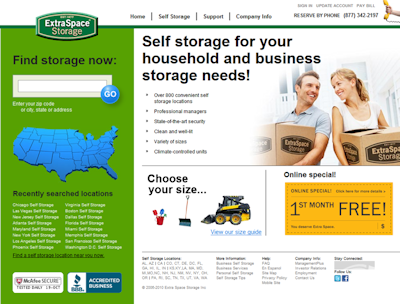5 Ways To Jump Ahead In Your Industry
We frequently hear about the consumer brands that dominate their markets. Amazon controls 25% of all Internet commerce. Zappos grew to a billion dollar company in ten years with its Web-friendly business model and rule-breaking culture. But who holds the dominant Internet-driven position in your slice of the economy? Is it you? It could be. […]
We frequently hear about the consumer brands that dominate their markets. Amazon controls 25% of all Internet commerce. Zappos grew to a billion dollar company in ten years with its Web-friendly business model and rule-breaking culture.
But who holds the dominant Internet-driven position in your slice of the economy? Is it you? It could be.
Right now, plans are being laid in almost every industry segment to leverage the Web and rule the roost. Over the next few years, one company in each marketplace is going to use the Internet to dominate their competitors, steal market share and enjoy big profits; from the company selling heat-reflecting paint in central Texas, to the company selling sophisticated cloud-management services to enterprises.

What does it take to be a Jumper in any industry segment?
I was able to see one emerging in the established and sleepy self storage industry at the Phone Smart Hawaii Unconference this month. This industry is mature, with serious competition in almost every city. Let’s look at the characteristics of Jumpers through the lens of Extra Space, a Jumper in the self-storage industry.
Accept The Internet As A Lever
There is a shift that happens when a business commits to the Internet as a business-building tool. I can almost tell you the moment that it has happened for several of my clients.
The boss doesn’t say, “We need to update our website” anymore. Instead she says, “We need to build our online business.”
Extra Space made that commitment. In an industry that still relied heavily on Yellow Pages ads and drive-by traffic. Extra Space took the time to document the changing trends driven by the Internet.
The trend in Figure 1 certainly was sobering for Extra Space. Do you know the impact of the Internet on your industry?
Develop A Testing Culture
The next shift that occurs at Jumper companies is when the organization decides that data will trump the opinion of the highest paid person in the room. When a culture of testing is in place, almost every assumption is up for grabs, from the working of the website to pricing and messaging.
The website is often the place that the testing culture takes root. It is relatively easy to test messaging, pricing, offers and other components of the business through the pages of the website.
Extra Space has a testing culture. Traffic to their website as increased from under 2 million unique visitors in 2008 to a projected 5 million in 2011.
From 2009 to 2010, their search and PPC traffic has grown more than 36%, but their conversion rate increased from by 52%, leading to a 108% increase in online rentals. That’s in one year.
Results like this don’t happen by accident. A look at their home page reveals some lessons learned from split testing.
- Location is the first question renters ask. Extra Space puts search in the strategic upper-left corner.
- Size is the next question. Extra Space uses images to draw the eye to their Size Guide.
- Providing a special offer is key. Testing revealed that the First Month Free offer proved to garner the most rentals, even more than three months at half price.
One sign of a testing culture is that the company doesn’t mind sharing its hardest-won findings with the world. They never stop testing, and thus are always one or two steps ahead of their staid brethren.
Invest Where It Counts
The testing culture means making an investment in the tools, talent and informative failures that come with testing. This doesn’t mean spending a lot more than your competitors, it means spending smarter.
Testing allows Jumpers to spend on the things that work, and stop spending on those things that don’t increase your sales or profits.
Extra Space employees eight full time IT employees and some fourteen consultants for work on SEO and PPC. There are an additional nine consultants engaged in site optimization alone. Extra Space is committed to the Web because they know what works.
Know Your Numbers
Testing isn’t enough. You must also live what you learn as an organization.
Jumpers can tell you what metrics are most important to their business, and can tell you the current numbers and trends. As an organization, they act differently based on what they learn.
For example, Extra Space knows that most visitors to a storage property did not shop around. They are comfortable paying full rental rates.
However, more than half of the renters who bought through the website did shop around, and Extra Space offers Web-only discounts to address this different behavior.
Extra Space knows that local search delivers visitors who rent at a higher rate than paid search visitors. Where do you think they are focusing their SEO efforts first?
Take A Non-Commodity Approach
Jumpers generally refuse to compete on price unless they enjoy a significant cost advantage. Even in markets where competition is high, Jumpers find ways to add value, and are often among the most expensive in their industry. Finding ways to charge more is an important benefit of testing.
The conventional wisdom in the self-storage market is that price is king. There are competing properties in every city and it is believed that you must discount to be competitive. Extra Space has found several ways to add value, and these may sound familiar to students of Best Buy, Zappos and Dell.
First, they don’t skimp on customer support. Extra Space has invested in a custom call center, which is now more effective at booking rentals than their on-site property managers.
Extra Space charges different rates for different channels. Walk-ins pay more than price-shopping Web visitors. Callers are often offered a special price immediately after location and unit size is determined.
Extra Space charges a premium. Through testing, they have discovered that they can raise prices for new renters after five months without increasing check-out rates. They also established that they can increase rates every nine months, while competitors wait twelve months or more.
These critical differences mean that Extra Space has more profit and more money with which to out market its competition. This is what feeds the loop, perpetuating an industry-leading position.
Jumpers Deliver Bottomline Results
Jumpers win. They grow faster, make more money and spend less.
Of four publicly traded US self-storage companies, Extra Space reported the highest revenue and highest net operating income (NOI) in the first quarter of 2011.
You can be the Jumper in your industry by accepting the Internet as a strategic channel, investing in it, building a culture of testing, and using your tests to find ways to charge more than your competition.
Opinions expressed in this article are those of the guest author and not necessarily Search Engine Land. Staff authors are listed here.
Related stories


